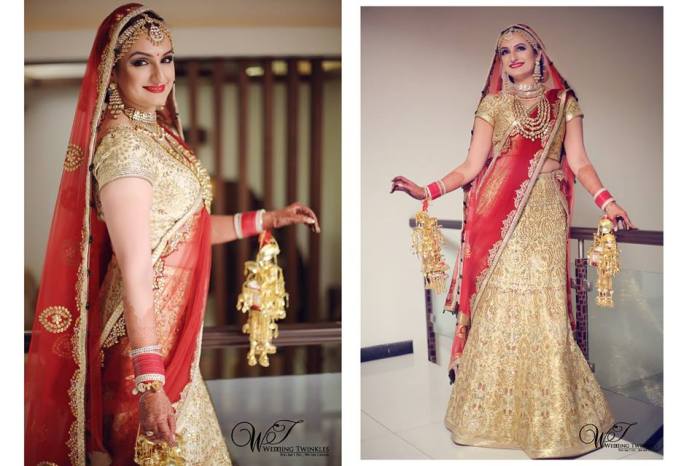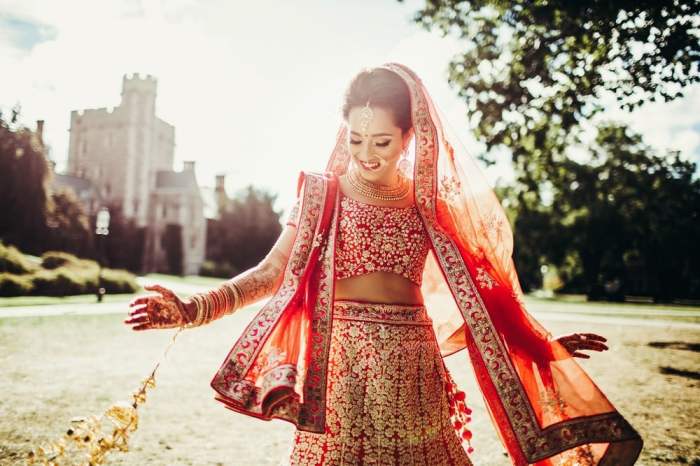Gold Indian Wedding Dress A Celebration of Tradition
The Splendor of Gold in Indian Wedding Dresses: Gold Indian Wedding Dress
Gold indian wedding dress – Gold holds immense cultural and symbolic significance in Indian weddings, representing prosperity, good fortune, and the auspicious beginning of a new life. Its presence in bridal attire is deeply rooted in tradition, reflecting the bride’s status and the family’s wealth. This article delves into the multifaceted role of gold in Indian wedding dresses, exploring its historical context, design variations, craftsmanship, and modern interpretations.
The Significance of Gold in Indian Weddings
Gold’s importance in Indian weddings transcends mere ornamentation; it’s intrinsically linked to cultural beliefs and traditions. For centuries, gold has been a symbol of wealth, power, and fertility, making it an indispensable element in bridal attire. The weight and intricacy of the gold adornments often reflect the family’s social standing and the bride’s future prosperity. Gold is traditionally used in various forms, including elaborate embroidery, intricate jewelry, and even gold-leaf embellishments on the fabric itself.
The use of gold varies across different regions of India, each with its unique traditions and symbolic interpretations.
| Region | Traditional Use of Gold | Symbolic Meaning | Modern Interpretations |
|---|---|---|---|
| South India | Heavy gold jewelry, intricate temple jewelry, gold-embroidered silk sarees | Prosperity, fertility, divine blessings | Contemporary designs incorporating traditional motifs, minimalist gold accents |
| North India | Gold zari embroidery on lehengas and sarees, heavy gold necklaces and bangles | Wealth, status, auspiciousness | Fusion styles blending traditional and modern elements, lightweight gold embellishments |
| West India | Gold-embroidered bandhani sarees, intricate Kundan jewelry | Good fortune, marital bliss, family legacy | Modernized bandhani patterns, fusion jewelry designs |
| East India | Gold-woven Banarasi sarees, traditional Bengali jewelry | Purity, auspiciousness, marital harmony | Contemporary interpretations of Banarasi weaves, fusion jewelry styles |
Styles and Designs of Gold Indian Wedding Dresses

Source: shaadiwish.com
Indian wedding dresses featuring gold come in a stunning array of styles, each reflecting regional traditions and modern design sensibilities. The most common styles include lehengas, sarees, and anarkali suits, all adorned with varying levels of gold embellishment.
Embroidery techniques like Zardozi, Aari, and Resham work are commonly employed to create intricate gold patterns. These techniques, often passed down through generations, showcase the exceptional craftsmanship of Indian artisans. Gold detailing often accentuates key design elements, such as the neckline, sleeves, and border of the garment, enhancing its overall visual appeal.
One can imagine a breathtaking gold lehenga crafted from rich Banarasi silk. The skirt would be adorned with intricate Zardozi embroidery depicting traditional floral motifs, while the choli (blouse) features delicate Aari work outlining a plunging neckline. The dupatta (scarf) would be elegantly draped, showcasing subtle gold threadwork that complements the overall opulence of the ensemble. The color palette would be a warm, inviting combination of gold, deep crimson, and emerald green.
The Craftsmanship and Materials Involved, Gold indian wedding dress
Creating a gold-embroidered Indian wedding dress is a labor-intensive process requiring immense skill and precision. Traditional techniques, often handed down through families, are employed to achieve the intricate designs.
- Traditional techniques include Zardozi, Aari, and Resham embroidery.
- Fabrics commonly used include silk (Banarasi, Kanjeevaram), brocade, and velvet.
- The process involves meticulously hand-stitching gold threads onto the fabric, creating intricate patterns and designs.
Different types of gold threads are used, each possessing unique properties:
- Pure gold threads: Offer the richest shine and luster but are more expensive and delicate.
- Gold-plated threads: More affordable and durable than pure gold threads.
- Wire-wrapped gold threads: Used for creating bold and textured designs.
Modern Interpretations and Trends

Source: yeahweddings.com
While traditional techniques remain valued, modern designers are constantly innovating, blending traditional craftsmanship with contemporary aesthetics. Lightweight gold embellishments, minimalist designs, and fusion styles are gaining popularity, offering brides a wider range of choices.
A timeline illustrating the evolution of gold in Indian wedding dresses might include:
- Pre-1950s: Heavily embellished, traditional styles dominate, showcasing the family’s wealth.
- 1950s-1980s: A blend of traditional and Western influences emerges, with lighter embellishments and more streamlined silhouettes.
- 1990s-2000s: Experimentation with different fabrics and embroidery techniques, incorporating bolder colors and patterns.
- 2010s-Present: A rise in minimalist designs, fusion styles, and sustainable practices, with a focus on lightweight and comfortable attire.
Visual Representation: Illustrative Descriptions
A richly embroidered gold lehenga might feature intricate floral patterns in shades of gold, interspersed with ruby red and emerald green accents. The Zardozi embroidery would be so dense that the fabric almost appears to shimmer with light. The lehenga’s skirt would flow gracefully, while the choli would be fitted, accentuating the bride’s figure.
A gold saree with delicate zari work would possess a subtle sheen, its texture luxurious and smooth against the skin. The zari work, woven seamlessly into the fabric, would create intricate patterns that would shimmer with every movement. The saree’s drape would be elegant and flowing, highlighting the bride’s grace and poise.
A gold anarkali suit with subtle gold detailing would exude understated elegance. The anarkali’s silhouette would be flattering, and the gold embellishments would be strategically placed, accentuating the neckline and hemline. The fabric would be lightweight and comfortable, allowing for ease of movement.
FAQ Compilation
How much does a gold Indian wedding dress typically cost?
The cost varies significantly depending on the fabric, embroidery intricacy, and designer. Prices can range from a few thousand to several lakhs of rupees.
How long does it take to create a custom gold Indian wedding dress?
Creating a custom dress can take several months, depending on the complexity of the design and the availability of artisans.
Can I find ready-to-wear gold Indian wedding dresses?
Yes, many designers and boutiques offer ready-to-wear options, though the selection may be more limited than custom-made dresses.
What is the best way to care for a gold Indian wedding dress?
Dry cleaning is generally recommended. Always follow the care instructions provided by the designer or manufacturer.

















